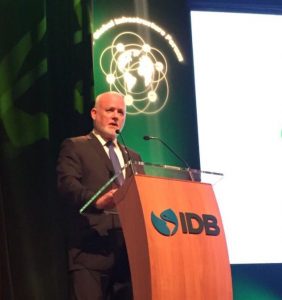As delivered
H.E. Mr. Peter Thomson, President of the 71st Session of the General Assembly, at 2017 Global Infrastructure Forum “Challenges of Infrastructure Investments and the Role of MDBs”
22 April 2017
Excellencies
Distinguished guests,
Ladies and Gentlemen,
First, thank you to the European Investment Bank and Inter-American Development Bank for organizing the 2nd Global Infrastructure Forum, and for inviting me to address you today.
This Forum, as called for in the Addis Ababa Action Agenda, is a critical step in our efforts to bring inclusive, sustainable and resilient infrastructure to developing countries, and to achieve the 2030 Agenda for Sustainable Development across our world.
The focus of this session on the particular challenges facing Least Developed Countries, Small Island Developing States, and Landlocked Developing Countries is especially prescient, as we look to ensure that our sustainable development efforts fulfill the 2030 Agenda’s commitment to leave no one behind.
Excellencies,
Investment in sustainable and resilient infrastructure is fundamental to achieving long-term sustainable economic growth –to creating jobs, building prosperity, reducing inequality, and strengthening social services. In short, improving the livelihoods of those in greatest need.
This includes the estimated 746 million people living in extreme poverty, the 1 billion people who do not have access to safe water, and the nearly 1.1 billion people who do not have access to electricity.
For LDCs, SIDS and LLDCs, the particular vulnerabilities imposed by their geographic circumstances exacerbate the challenges faced in mobilizing resources for sustainable development. Often this includes their isolation from world markets, and exposure to the devastating impacts of climate change.
For Small Island Developing States like my own country, Fiji, investments in climate-resilient infrastructure have become a fundamental enabler of long-term sustainable economic growth.
Compounding this situation is the fact that unless specific efforts are now taken to facilitate sustainable infrastructure investments for LDCs, SIDS and LLDCs, their situation is at risk of worsening over coming years, as the effects of population growth and urbanization cause even greater pressure on cities, and stress to infrastructure, social cohesion, and, of course, degradation of the natural environment.
It was with all this in mind that earlier this week I convened a High-Level SDG Financing Lab at UN Headquarters in New York, which included a specific segment on fostering economic growth and development, and building resilient infrastructure.
The lab brought together partners from across Governments, the World Bank Group, civil society, and the private sector, to examine ways to mobilize the resources needed to achieve the Sustainable Development Goals by 2030.
Among the findings, a number of key steps were identified of relevance to helping fill the infrastructure financing gap for LDCs, SIDS and LLDCs.
Firstly, the financing needed to fund the SDGs already exists around the world, but much more needs to be done to get the regulatory frameworks in place to shift investments towards SDG implementation.
Doing so requires a scaling-up of investments including financial and technical support, so that countries have the human and institutional capacity needed to strengthen domestic resource mobilisation, mobilize sustainable investments, and package infrastructure needs into bankable projects that attract investors.
Secondly, despite the SDGs making economic sense for businesses, global financing being available, and bankable and sustainable projects being developed, there continues to be a market failure that hinders the flow of financing towards sustainable investment options.
Greater attention therefore needs to be given to improving access to information for investors about market opportunities in LDCs, SIDS and LLDCs. This can help to de-risk investments, and shift the large pools of funds currently invested in underperforming assets towards sustainability.
Thirdly, we need to support nationally-led efforts to build sustainable peace, to improve good governance, rule of law, human rights, gender equality, and social inclusion, as part of a comprehensive approach to help countries attract sustainable investments, drive long-term economic growth, and achieve the SDGs.
And finally, we must use all possible opportunities, like the SDG Lab and the Global Infrastructure Forum, to bring together all stakeholders to help identify and address LDCs, SIDS and LLDCs’ infrastructure and capacity gaps, highlight opportunities for sustainable investment and cooperation, and build inclusive and strategic partnerships. Such partnerships can leverage comparative advantages, drive coordinated efforts, and mobilize sustainable investments.
Multilateral institutions, including the United Nations, and the Multilateral Development Banks, are of particular importance in this regard.
For the Multilateral Development Banks, this includes by providing technical assistance and capacity-building, by helping to bring together local infrastructure investment opportunities with private sector and institutional investors, and by increasing investments in infrastructure, innovation, and technology projects, to bring them to scale and lower costs for the global good.
And for the United Nations, it includes by providing a platform to bring public and private sector actors together to bridge understanding of our shared sustainable development interests and goals, and to serve as a policy space between Members States and global financial system actors, by giving guidance on financing the SDGs.
Excellencies,
Addressing the infrastructure investment gap for developing countries – and for LDCs, SIDS and LLDCs in particular – is fundamental to our efforts to implement the 2030 Agenda.
Therefore, we must continue to work collaboratively to mobilize resources at the speed and scale necessary to implement the SDGs. We are mandated by the leaders of all 193 Member States of the United Nations to achieve the exponential social, economic and environmental transformation that the 2030 Sustainable Development Agenda demands.
Getting the wheels turning on all 17 SDGs is a responsibility we all share, so let’s put all of our shoulders to those wheels and move on down the best path we have devised for humanity’s sustainable place on this planet.
I thank you.


